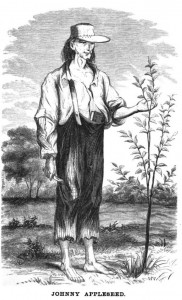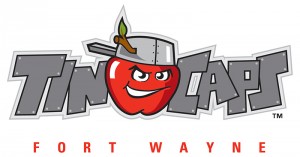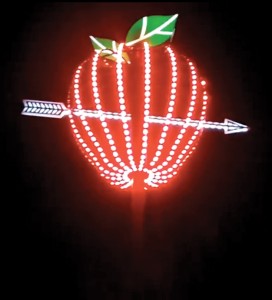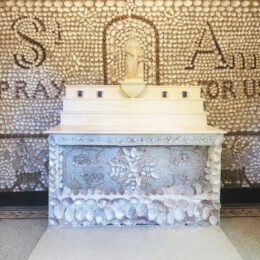Indiana has no officially designated “state fruit.” But if it did, chances are the healthy and wholesome apple would be the apple of Hoosier eyes.
Not only is the apple by far the most plentiful fruit crop grown in Indiana, but Johnny Appleseed, the pioneer nurseryman who cultivated orchards from Pennsylvania to Illinois, was himself planted here when he died in 1845.
Apples are so much a part of Indiana it could be said, apples are even our state capital’s middle name: “Indian-Apple-Us.” (OK … we’ll leave that pun for only the hardest core apple eaters among us.)
But far and wide, from the Wabash Valley to the banks of the Ohio and across America, apples are everywhere to eat. We use them in figures of speech. And they just have a natural appeal across all age groups as symbols and motifs — from our ABCs to NASDAQ, from the single Tree of Knowledge in the Garden of Eden to pastures of plenty across our fruited plains.
So, Electric Consumer invites you to take off your socks and shoes and walk a while in Johnny Appleseed’s bare footsteps as we celebrate the coming apple harvest and trace apples in all their juiciest and ancillary applications.
Apples and Indiana
Indiana has approximately 4,000 acres of apples growing with annual production of about 1.2 million bushels, says Purdue University. National apple production is 250 million bushels. About half of that is produced in Washington state alone. Indiana ranks 15th nationally in apple production.
Apples are a symbol of fall to many people. Farm markets draw customers out to purchase local apples, fresh cider, other fruits and vegetables, various preserves and the like and to enjoy the autumn weather. Many growers have discovered they can sell not only the produce but also the farm experience. Activities such as petting zoos, corn mazes and school tours not only attract more customers but also provide additional profit centers.
In addition, throughout this month and next, communities will be coming together to celebrate the apple harvest with festivals. While a list of many apple festivals is provided on page 19, one of the largest fests devoted to apple devotees is, of course, the Johnny Appleseed Festival in Fort Wayne. Begun in 1974, on the 200th anniversary of Appleseed’s birth, the festival — held this year Sept. 19-20 — features over 200 booths and has included vendors from over 42 states.
The uniqueness of the Johnny Appleseed Festival is maintained by its stringent requirements for vendors. No modern conveniences are allowed. Cooking must be done over an open fire without the use of propane gas. Vendors are required to dress in 1800 period dress. Products for sale, demonstrations, entertainment and food all have to have been potentially available in the 1800s.
The festival takes place at Johnny Appleseed Memorial Park near Johnny Appleseed’s headstone which bears his real name: John Chapman. The Johnny Appleseed gravesite is nationally known, but some controversy exists on where he is actually buried.
Who was Appleseed?
 Jonathan Chapman was born Sept. 26. 1774, in Leominster, Massachusetts. His father, Nathaniel Chapman, a farmer, fought as a minuteman at the Battle of Concord, and later served in the Continental Army under Gen. George Washington.
Jonathan Chapman was born Sept. 26. 1774, in Leominster, Massachusetts. His father, Nathaniel Chapman, a farmer, fought as a minuteman at the Battle of Concord, and later served in the Continental Army under Gen. George Washington.
Little is known about Chapman’s early life. Biographers suggest he may have traveled west to Ohio in 1805 with his brother initially, meeting up with the rest of his family which had migrated west. It’s likely his father encouraged him to become an orchardist, setting him up with an apprenticeship in that area. By 1812, John Chapman was working independently as an orchardist and nurseryman.
Chapman traveled widely, particularly in Pennsylvania and Ohio, pursuing his profession. While the legend of Johnny Appleseed depicts him scattering seeds willy-nilly, he was a careful, organized businessman. Over a period of nearly 50 years, he bought and sold tracts of land and established nurseries. After a few years, he would return to tend the trees and sell off the orchard and surrounding land. Orchards, at that time, served the critical legal purpose of establishing land claims along the frontier. As a consequence, Chapman, who never married or settled in one place, owned around 1,200 acres of valuable land at the time of his death.
Chapman was also a self-appointed itinerate missionary and preacher of the Swedenborgian Christian faith or New Church. He spread his faith while traveling to establish orchards, preaching to both pioneers and Native Americans he encountered along the way.
Among Chapman’s eccentricities was a threadbare wardrobe, which often did not include shoes. He was a staunch believer in animal rights and denounced cruelty toward all living things. Chapman died of pneumonia March 18, 1845, while in Fort Wayne.
Though already a legend in his own time, Chapman’s “Appleseed” image as a folk hero developed quickly after his death. Appleseed is the official folk hero of Massachusetts. The character has served as the subject of children’s books, movies and stories since the mid-1800s.
TinCaps and Tell
With Johnny Appleseed such a fixture in Fort Wayne’s past and present, the name “TinCaps” was selected when Fort Wayne’s minor league baseball team was looking for a new name for the 2009 season. That was the first season for Fort Wayne’s new downtown baseball park, Parkview Field. The team’s name is a reference to the legend that Appleseed wore his tin cooking pot on his head. The team’s primary logo is an apple wearing the trademark “Tin Cap.” The team’s mascot is Johnny himself.
 The Fort Wayne TinCaps is a Class A minor league baseball team affiliated with the San Diego Padres. In the first season as the TinCaps, the team won its first Midwest League Championship.
The Fort Wayne TinCaps is a Class A minor league baseball team affiliated with the San Diego Padres. In the first season as the TinCaps, the team won its first Midwest League Championship.
On the other end of Indiana from Fort Wayne, Tell City is a town that also uses apples prominently. The Ohio River community was founded in 1858 by Swiss and German immigrants who named the town after the legendary Swiss folk hero William Tell.
According to legend, in November 1307, Tell and his son, Walter, came to Altdorf, which was under Austrian control. The new local ruler, Hermann Gessler, had placed his cap on a pole in the town square and ordered all to bow beneath it. When Tell refused, Gessler had him and his son seized. Knowing of Tell’s reputation as a marksman, Gessler gave Tell one chance for freedom: he had to shoot an apple from his son’s head with a single bolt from his crossbow, or both would be executed.
At first, Tell pleaded for his son’s life. But Walter assured his father he was not afraid and had faith his father wouldn’t miss. Reluctantly, Tell drew two bolts from his quiver. He fired the first which famously split the apple. After releasing Tell and his son, Gessler asked what the second bolt was for. Tell told him had he missed and killed his son, the second bolt would not have missed its target: Gessler’s evil heart.
Gessler had Tell seized again at the revelation and chained. He had Tell transported to a dungeon across Lake Lucerne for safekeeping. But as the boat made its way across the lake, a violent storm blew up. Tell was released to help steer the boat to safety. As Tell maneuvered the boat toward shore, he leapt to freedom upon a rock jutting out into the lake.
Tell then ran cross country and met up with Gessler and his entourage at a mountain pass. There, hiding among the cliffs, Tell fired a single bolt from his crossbow and struck the tyrant in the heart. The legend of Tell’s apple shot and assassination of Gessler became a centerpiece of Swiss liberation and Swiss patriotism.
Tell City adopted the apple shot symbol, too. It’s sculpted into the stone high above the 1928 high school’s main entrance, part of the school’s crest, boldly painted on the city’s flood wall and used extensively by the city and businesses. And, as New Year’s rolls in, Tell City drops an electrically lighted “Big Apple,” akin to the Big Apple’s Times Square celebration, at City Hall Park near its bronze statue of Tell and son.
Apple appeal
So, whether heading out this fall to take in apple orchards, the harvest, cider, caramel apples or fun and games, like bobbing for apples; or festivals; or Fort Wayne for the season’s finale of the TinCaps — or if you plan to wait till New Year’s Eve to see a big lighted apple drop — Hoosiers certainly have a variety of apples for which to keep their eyes peeled.
Richard G. Biever is senior editor of Electric Consumer. Portions of this story were culled from multiple sources including The Fort Wayne Johnny Appleseed Festival, The Fort Wayne TinCaps, the U.S. Apple Association, and more. For “Apple Slices” of trivia, click here!



